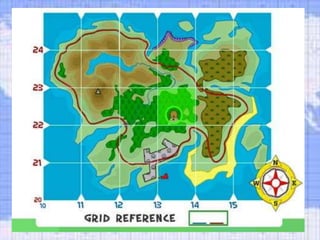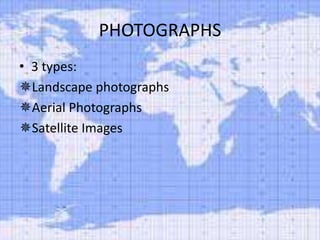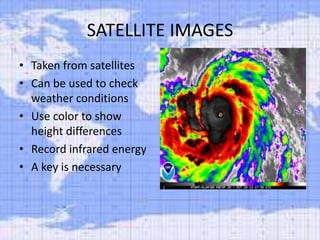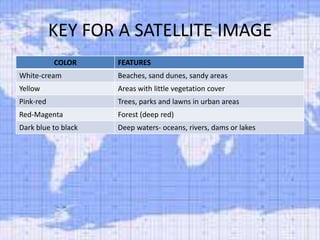Mapping skills
- 2. LATITUDES âĒ Horizontal lines (east to west) âĒ Divide the earth into northern and southern hemispheres âĒ Measured in degrees North & South âĒ Maximum possible latitude: 90 degrees (North & south poles)
- 3. LONGITUDES âĒ Vertical lines (north to south) âĒ Divide the earth into Eastern and western hemispheres âĒ Measured in degrees East & West âĒ Maximum possible longitude: 180 degrees
- 4. INTERNATIONAL DATE LINE âĒ Opposite the prime meridian âĒ Lies in the pacific ocean âĒ Not a straight line âĒ Separates two calendar days âĒ Eastern hemisphere is one day ahead of the western hemisphere
- 5. PUTTING LATITUDES & LONGITUDES TOGETHER âĒ Together they form a grid âĒ Points of intersection are called coordinates âĒ Used to tell locations âĒ Latitude comes before longitude in locations
- 7. PHOTOGRAPHS âĒ 3 types: ïŊLandscape photographs ïŊAerial Photographs ïŊSatellite Images
- 8. SATELLITE IMAGES âĒ Taken from satellites âĒ Can be used to check weather conditions âĒ Use color to show height differences âĒ Record infrared energy âĒ A key is necessary
- 9. KEY FOR A SATELLITE IMAGE COLOR FEATURES White-cream Beaches, sand dunes, sandy areas Yellow Areas with little vegetation cover Pink-red Trees, parks and lawns in urban areas Red-Magenta Forest (deep red) Dark blue to black Deep waters- oceans, rivers, dams or lakes








